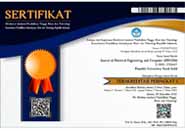Health Risk Level Prediction for Hajj Pilgrims Using Random Forest and Bayesian Optimization (Case Study: Hajj Pilgrims of Balikpapan Embarkation)
Authors (s)
(1) * Luthfi Bhaktiawan Husag
 (UNIVERSITAS AMIKOM YOGYAKARTA)
(UNIVERSITAS AMIKOM YOGYAKARTA) Indonesia
(*) Corresponding Author
AbstractThe Hajj pilgrimage is one of the largest religious rituals in the world, involving millions of pilgrims from various countries. The physical condition and health of pilgrims are crucial factors in ensuring the smooth execution of the Hajj. Data from the Ministry of Health indicates that the mortality risk among Hajj pilgrims tends to increase annually, particularly in the elderly age group and among pilgrims with a history of certain diseases, such as hypertension, diabetes, and heart disease. This study aims to compare the performance of a Random Forest model optimized with Bayesian optimization against a Random Forest model without any optimization in predicting the health risk level of Hajj pilgrims at the Balikpapan Embarkation. The research findings show that the Random Forest model optimized with Bayesian Optimization provides superior performance compared to the non-optimized model, using K-Fold Cross-Validation for data splitting to avoid imbalance. The optimized model achieved an average Accuracy of 88.25% and an F1 Score of 88.19%, higher than the standard model which recorded 87.99% and 87.95% on the same metrics. Although their AUC scores were nearly identical (95.46% vs. 95.47%), the improvement in accuracy and F1 Score indicates that Bayesian Optimization can produce a more balanced and accurate classification model. In conclusion, the application of Bayesian Optimization to Random Forest is proven effective for enhancing the predictive accuracy of Hajj pilgrims' health risks, potentially supporting more proactive Hajj healthcare services. |
Keywords
Full Text: PDF
Refbacks
- There are currently no refbacks.
Copyright (c) 2025 luthfi bhaktiawan husag









